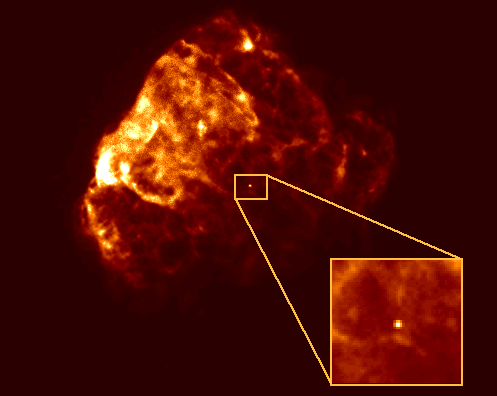Supernova Remnant and Neutron Star

Explanation:
A massive star ends life as a supernova, blasting
its outer layers back to interstellar space.
The
spectacular death explosion is
initiated by the collapse of what has become an impossibly dense
stellar core.
However, this core is not necessarily destroyed. Instead, it may be
transformed into an exotic object with the density of an
atomic nucleus but more total mass
than the sun -
a neutron star.
A neutron star is hard to detect directly because it is
small (roughly 10 miles in diameter)
and therefore dim, but newly formed in this violent crucible
it is intensely hot,
glowing in X-rays.
These
X-ray images from the orbiting ROSAT observatory may offer a premier
view of such a recently formed neutron stars' X-ray glow.
Pictured is the supernova
remnant Puppis A, one of the brightest
sources in the X-ray sky,
with shocked gas clouds still expanding and
radiating X-rays. In the inset close-up view,
a faint pinpoint source of X-rays is visible which is most likely
the young neutron star,
kicked out by the asymmetric explosion and
moving away from the site of the original supernova at about 600 miles
per second.
Authors & editors:
Robert Nemiroff
(MTU) &
Jerry Bonnell
(USRA)
NASA Web Site Statements, Warnings,
and Disclaimers
NASA Official: Jay Norris.
Specific
rights apply.
A service of:
LHEA at
NASA /
GSFC
& Michigan Tech. U.

